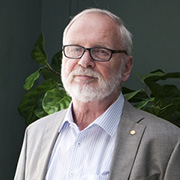Hartmut Michel

Hartmut Michel
1988 Nobel Prize in Chemistry
Photosynthesis is the process where light, water and carbon dioxide are converted into oxygen and chemical energy, a precondition for life on earth. These reactions are mediated by various membrane proteins. To have a complete understanding of their mechanism of action, atomic detail of their structure is required. It was once considered impossible to obtain such insights using standard protein X-ray crystallography. However, in 1982, the situation changed dramatically when Professor Hartmut Michel succeeded in preparing highly ordered crystals of a photosynthetic reaction centre from a purple bacterium, allowing the determination of its structure in atomic detail.
Prof Michel was awarded the Nobel Prize in Chemistry in 1988, together with fellow colleagues and collaborators Johann ‘Hans’ Deisenhofer and Robert Huber, for “the determination of the three-dimensional structure of a photosynthetic reaction centre”. Since 1987, Prof Michel has been with the Max Planck Institute for Biophysics in Frankfurt, Germany as Director in the department of molecular membrane biology. He is also Adjunct Professor at University of Frankfurt since 1989.
As a child, Prof Michel enjoyed outdoor activities and playing with local children in ‘gangs’ for fun. By age 11, however, he was rarely seen outside as he chose to spend his time reading in his local library. In 1969, he began studying biochemistry at the University of Tübingen, which at that time was the only place in Germany where a curriculum in biochemistry was available. His career in research took flight in 1974 when he carried out experiments as part of his biochemistry diploma in the lab of Professor Dieter Oesterhelt, his mentor and without whom the Nobel-winning research would not have been possible. Prof Michel gives much credit to Prof Oesterhelt, although the latter had declined to be named among the contributors.
According to Prof Michel, one must “have a clear image of your collaborator”, and Johann ‘Hans’ Deisenhofer was his partner of choice during the reaction centre project. Throughout their collaboration, Prof Michel and Hans became the best of friends. They split the work in such a way that optimised their individual skills and abilities: Prof Michel did all the experiments and data collection, while Hans computationally calculated the protein structure.
“It was a trustful collaboration”, says Prof Michel. “Very frequently, you see scientists who are overambitious; they don’t want to give you credit and they are not honourable.” He advises against pursuing such collaborations, as they will lead to nothing but trouble.
He also believes it is important to not become frustrated with challenging work, as projects will often fail on the path to success. “Life always goes up, don’t stop” is Prof Michel’s approach to his work and life.

